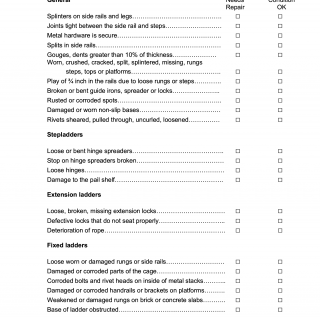Ladder Inspection Checklist
A ladder inspection checklist is a form used to ensure that ladders are safe to use before they are put into service. The primary purpose of this form is to prevent accidents and injuries that could occur due to the use of faulty ladders.
The form consists of several parts, including a section for ladder identification, inspection details, and a checklist of items that must be verified before the ladder can be used. The important fields in this form include the ladder's identification number, the date of inspection, and the name of the inspector.
The parties involved in the use of this form are the ladder owner and the ladder user. It is important to consider the safety of the user when writing this form. Data required when writing this form includes the ladder's identification number, the date of inspection, and the inspector's name. No additional documents need to be attached to this form.
An application example of this form is when a construction company wants to ensure that all ladders are safe to use before beginning work on a new project. Another example is when a homeowner wants to ensure that the ladder they own is safe to use before carrying out maintenance work on their property.
The strengths of this form include its ability to prevent accidents and injuries, while its weaknesses include the possibility of human error during inspections. Opportunities for improvement include the use of technology to automate inspections and reduce the likelihood of errors. There are no significant threats related to this form.
Alternative forms that could be used in place of a ladder inspection checklist include a ladder training checklist or a ladder maintenance checklist. The main difference between these forms is their focus - the ladder training checklist focuses on ensuring that users know how to use ladders safely, while the ladder maintenance checklist focuses on ensuring that ladders are properly maintained.
The use of a ladder inspection checklist can impact the future of the participants in a positive way by reducing the likelihood of accidents and injuries. The form should be submitted to the ladder owner for record-keeping purposes and stored in a safe place for future reference.

